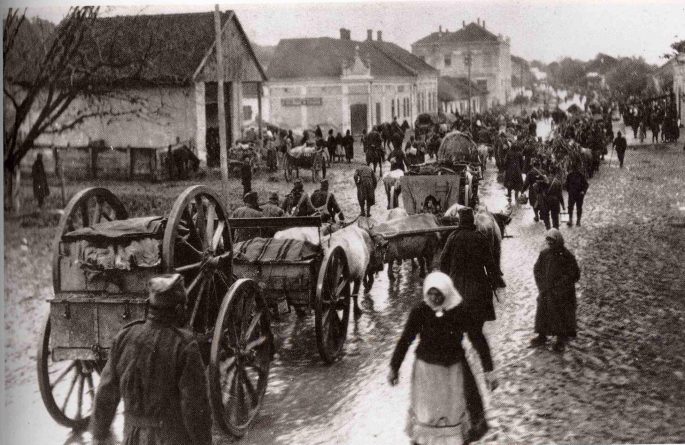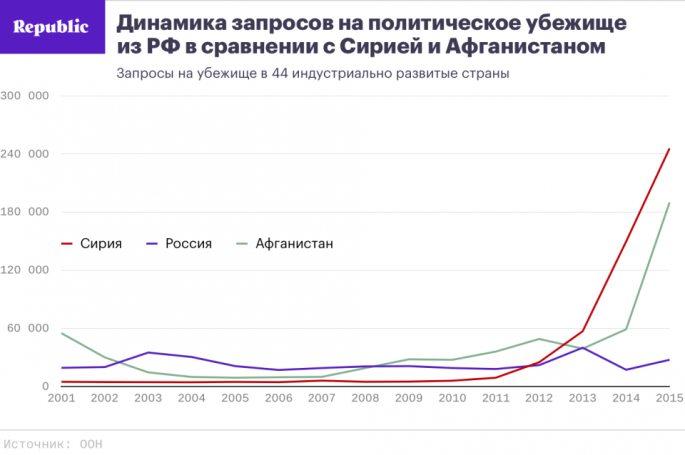Taking refuge
Tens of thousands of Russian citizens are leaving their country in search of international protection. What chances do they have?

Yevgeniy Karasyuk
The number of Russians hoping to be granted political asylum abroad is once more on the increase. Fresh data from the US Department of Homeland Security show that Russian citizens submitted 1912 requests for asylum, a record figure for the last 22 years: the former peak was in 1994 when there were 2127 requests. Most of those emigrating from Russia try to go to Europe: for some of the EU countries the Russians are from time to time the biggest group of foreigners seeking to be granted political asylum. How many actually achieve it?

Applications for asylum in 44 developed countries
Red line – Syria
Purple line – Russia
Blue line – Afghanistan
Source: United Nations
Afghanistan, and more recently Syria, make a very considerable contribution to world refugee statistics. But, from time to time, Russia manages to compete with even the most war-ravaged countries.
In 2013, for instance, 39,800 Russian citizens applied to the governments of 44 developed countries (37,000 of them to EU countries). This put Russia in second place after Syria among countries with the greatest number of applicants for political asylum (the last time this happened was in 2007).
In Poland, for example, 85% of applications in 2013 were from Russians. The European establishment could not understand what had caused this surge (an increase of 72% by comparison with 2012) and tried to set up a workshop with their Russian colleagues to study the phenomenon. But relations between the EU and Russia deteriorated dramatically in 2014, so joint projects to study the problem of refugees lost any meaning.
Which cannot be said of refugee status. Someone with this status not only receives the protection of the country to which he has applied, but also free living space, benefits, insurance and the right to work (including during the period while the application is being considered). The refugee will have the right to be granted citizenship in the future, as well.

Number of applications in 2013
Germany
Poland*
France
Austria
Sweden
Denmark
USA
Belgium
Switzerland
Norway
* 12,849 according to statistics from Bureau for Logistics and Foreign Support
Source: United Nations, 2013
In 2011 Russia was the biggest supplier of refugees to France (4000 registered applications), outstripping even the war-torn Francophone Democratic Republic of Congo. It was the same story in Germany in 2013. Western Germany, together with Poland, receives two thirds of the applications from potential Russian refugees wishing to settle in Europe; the majority – 60-90% depending on the period – come from Chechnya.
In the first four months of 2016, four out of five new arrivals in Germany requesting political asylum were Chechens: in April alone, according to the German government, 850 Russians arrived in Germany, and the final tally for 10 months shows that Germany received 10,172 requests from Russia. For a long time the official reason for granting political asylum to Chechens in EU countries was given as danger to life and limb resulting from hostilities, and the violation of basic rights and freedoms. Political views and sexual orientation figure much less often in Russian applications (the first Russian gay to be granted political asylum in Germany was in 2013).
German politicians are increasingly frequently having to answer questions about the link between the stream of Chechen refugees and the growth of ethnic criminality, a topic which frequently comes up in the media. Information about the last special operation carried out by the German police to clamp down on a crime ring, consisting mainly of Chechens who had requested political asylum in Germany, was made public at the end of November. The arrested gang members were accused of robbery with violence, extortion, intimidation, holding people under duress, and grievous bodily harm. In one way or another this all affects the approval rate for applications.

in Poland 2013 in Germany 2014
Total number of applications
Granted refugee status
Granted additional support/additional protection*
Granted ‘leave to remain’/category of ‘humanitarian protection’*
Applications refused
*Receives fewer advantages than a refugee; mainly protection from deportation
Source: Bureau for Logistics and Foreign Support, Federal Office for Migration and Refugees
German and Polish statistics show that a very small percentage of those requesting political asylum actually become refugees. In 2015, for example, the German government only granted only 6% of applications from Chechnya. One of the most common causes for refusal is infringement of procedural requirements. The German authorities try to adhere rigorously to the rules of the Dublin Convention, according to which applicants for political asylum have to submit their request in the first country in which they arrive. Poland is usually the first country for Russians crossing the border with the EU. Grzegorz Schetyna, former Interior Minister of Poland, has said that during the past 20 years Poland has given refuge to approximately 90,000 Chechens, which is nearly 7% of the [Chechen] republic’s population at the time of the First Chechen War (1994). By 2009 (the official conclusion of anti-terrorist operations in the North Caucasus), the Poles had granted asylum to more than a third of applicants, but then the percentage of positive decisions on granting asylum fell to the same 6%.

Figures for 2015
Men 49% Women 51%
Source: Eurostat, Pew Research Centre
It is logical to assume that most of the Russian requests for asylum in EU countries come from mothers and children. More of the applicants are women, and in over half the cases the potential refugees are minors (less than 18 years old, according to EU standards). Of the European (Serbia, Ukraine, Albania, Kosovo) and non-European countries including Afghanistan and Syria, Russia has the most young refugees. This is clearly to a large extent linked with the traditionally high birth rate in the North Caucasus region (figures for Chechnya are twice as high as for Russia on average).

Number of applications in 2013
China
Egypt
Ethiopia
Nepal
Syria
Venezuela
Iran
Russia
Haiti
Iraq
Source: US Department of Homeland Security, Refugee, Asylum and Parole System, Executive Office for Immigration Review of the US, Department of Justice
The flow of Russian refugees to the USA is smaller than to the countries of the European Union. Fewer than 2000 requests have been submitted in 2016 (and less than 1500 in 2015), which is equivalent to the rate for Austria alone. The applicants are different too. Refugees from Russia are increasingly often representatives of sexual minorities, which is partly to do with the Russian LGBT community’s reaction to the Russian law passed in 2013 banning ‘gay propaganda.’ The reasons adduced in requests are less often to do with political repression or human rights. The likelihood of Russian applicants being allowed to stay in America legally should not be overstated. In the early 00s, as shown in the report “Asylum and ‘Credible Fears’ Issues in U.S. Immigration Policy,” the American government granted approximately half the requests for refugee status, after which the percentage sank to less than a third. In the almost 10 years from 2000 to 2009, 3587 Russians were granted refugee status in the States, which is considerably less than figures for China, Columbia, Haiti, Ethiopia, Venezuela and Armenia.
This article was first published in Republic



